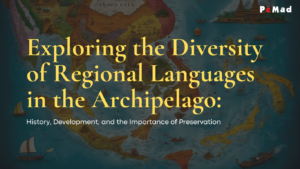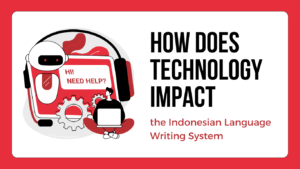Languages have an incredible ability to bridge gaps, connect cultures, and create bonds across borders. While global languages like English, Spanish, and Mandarin often take the spotlight, there are other languages that are quietly making their mark on the world stage.
One such language is Indonesian. In recent years, there has been a remarkable surge in the popularity of learning Indonesian language abroad. Indonesia, with its rich culture, stunning landscapes, and vibrant economy, is becoming an increasingly attractive destination for those seeking to expand their linguistic horizons.
In spite of the fact that many countries have their own distinct languages, Indonesia is the second most linguistically diverse country in the world.
In this article, we’ll take an exciting journey into the unexpected popularity of learning Indonesian abroad, exploring the reasons behind its rise, its role in global linguistics, and the initiatives driving this trend.
Content :
ToggleThe Emergence of Indonesian’s Popularity in Another Country
Indonesian, known as Bahasa Indonesia, serves as the official language of Indonesia. With its diverse population and a rich tapestry of local dialects, Indonesian plays a crucial role in unifying the nation.
Numerous countries across the globe boast a multitude of languages, a testament to the rich tapestry of cultures within their borders. The variations in languages are a direct result of the diverse cultural heritage in each region.
As per data from Ethnologue, Papua New Guinea stands as the global leader in linguistic diversity in 2022. This nation proudly claims a staggering 840 distinct languages in active use.
Taking the second spot is Indonesia, which houses an impressive array of 720 languages within its borders. Presenting the Top 10 Countries with the Most Languages in 2022:
-
- Papua New Guinea: 840 languages
- Indonesia: 720 languages
- Nigeria: 527 languages
- India: 456 languages
- United States: 337 languages
- Australia: 317 languages
- China: 307 languages
- Mexico: 301 languages
- Cameroon: 277 languages
- Brazil: 238 languages
A country with many languages scattered around it, Indonesia has shown that it has a prominent position as the second country with the most languages.
Traditionally, languages like Spanish, French, or Mandarin have held the limelight in language learning, but Indonesian is quietly but surely gaining ground. It’s fascinating to see how many people, from different corners of the globe, are now showing a keen interest in mastering the Indonesian language.
Indonesian’s Growing Influence: Reasons Behind Its Popularity
Economic and Business Opportunities
Indonesia’s economy is on an upward trajectory, making it a prominent player on the global stage. As the country’s economic significance grows, so does the demand for professionals who can communicate effectively with Indonesian partners and clients.
Moreover, Indonesia is a member of the Asian Economic Community and a participant in the ASEAN Free Trade Area. This entails the unhindered flow of trade and services.
The emerging middle class demonstrates enthusiasm for experimenting with novel products and services, and more than 102 million Indonesians engage with the internet and platforms like Facebook and Twitter.
Learning Indonesian provides a competitive edge for individuals in industries such as trade, tourism, and international business. The ability to converse in the native language opens doors for smoother negotiations and a deeper understanding of local customs.
However, achieving effective business communication in Indonesia hinges on understanding their culture, mastering appropriate greetings for business associates, and engaging a reputable translation firm to safeguard against any loss of meaning during negotiations.
Cultural Exchange and Diplomacy
In an increasingly interconnected world, cultural exchange and diplomacy are vital components of international relations.
Learning Indonesian enables individuals to engage with the rich cultural heritage of Indonesia, fostering cross-cultural understanding.
This is particularly valuable for diplomats, cultural exchange programs, and individuals working in international organizations. Proficiency in Indonesian allows for more meaningful interactions and a deeper appreciation of Indonesia’s diverse traditions.
Economic and Business Opportunities
Indonesia’s economy is on an upward trajectory, making it a prominent player on the global stage. As the country’s economic significance grows, so does the demand for professionals who can communicate effectively with Indonesian partners and clients.
Moreover, Indonesia is a member of the Asian Economic Community and a participant in the ASEAN Free Trade Area. This entails the unhindered flow of trade and services.
The emerging middle class demonstrates enthusiasm for experimenting with novel products and services, and more than 102 million Indonesians engage with the internet and platforms like Facebook and Twitter.
Learning Indonesian provides a competitive edge for individuals in industries such as trade, tourism, and international business. The ability to converse in the native language opens doors for smoother negotiations and a deeper understanding of local customs.
However, achieving effective business communication in Indonesia hinges on understanding their culture, mastering appropriate greetings for business associates, and engaging a reputable translation firm to safeguard against any loss of meaning during negotiations.
Indonesian Language Learning Initiatives
The surge in interest hasn’t gone unnoticed. Various language learning programs, both online and offline, have cropped up to meet the demand for Indonesian language education.
These initiatives provide accessible and structured approaches to learning Indonesian, catering to individuals with varying levels of proficiency.
Online platforms, language schools, and cultural centers offer resources for individuals eager to embark on the journey of learning Indonesian.
These initiatives provide a range of materials, from introductory language courses to immersive experiences that encompass not only language but also cultural understanding.
The Country that Learns Indonesian
Surprisingly, Indonesia’s influence is not limited to its own borders. In neighboring countries like Malaysia and Singapore, learning Indonesian has become a valuable asset due to their proximity and economic ties with Indonesia.
People in these countries often learn Indonesian to enhance their career prospects.
The Inclusion of Bahasa Indonesia in Curricula Across Nations
Indonesian has found its place in the curriculum of several schools and universities around the world. Countries like Australia, the Netherlands, and the United States have recognized the importance of the Indonesian language and offer programs for students to learn it. This institutional support further highlights the language’s global significance.
There are a few countries and regions where Indonesian is taught as a foreign or second language due to historical, cultural, or trade ties. Here are some examples:
-
- Australia: Indonesian is commonly taught in Australian schools as part of the foreign language curriculum. Indonesia’s proximity to Australia and its significance in the Asia-Pacific region contribute to the popularity of Indonesian language courses.
- Malaysia: Indonesian is sometimes taught in schools and universities in Malaysia. This is due to the linguistic similarity between Indonesian and Malay, which is one of the official languages of Malaysia.
- Netherlands: Dutch universities and language institutes often offer Indonesian language courses because of the historical ties between Indonesia and the Netherlands.
- United States: Some universities and language schools in the United States offer Indonesian language programs. This is often linked to academic or cultural interest in Southeast Asia.
- Singapore: While Malay is one of the official languages of Singapore, Indonesian is occasionally taught as a foreign language because of its linguistic similarity to Malay.
Indonesian’s Role in the Global Linguistic Landscape
Indonesian, also known as Bahasa Indonesia, is the official language of Indonesia and is spoken by the majority of its population. Beyond its borders, Indonesian has been recognized as a language of the Association of Southeast Asian Nations (ASEAN). It serves as a lingua franca in the region, facilitating communication between speakers of different native languages.
The rise of Indonesian as a foreign language highlights the growing importance of Southeast Asia in the global landscape. It stands alongside other Asian languages as a testament to the region’s increasing influence in various fields, from economics to culture.
As individuals, businesses, and institutions recognize the benefits of learning Indonesian, the language continues to carve its place in the global linguistic landscape. Its journey from a regional language to an international communication tool underscores the power of language in forging connections that transcend borders.
Conclusion
The surprising popularity of learning Indonesian abroad is a testament to the global community’s growing fascination with Indonesia’s rich culture, economic potential, and academic opportunities.
As more people recognize the benefits of mastering this vibrant language, the demand for Indonesian language learning initiatives will likely continue to rise. This trend not only enriches individual experiences but also fosters stronger cultural ties and international collaboration.
As Indonesia gains recognition for its economic, cultural, and diplomatic significance, it opens up a world of opportunities for those who embark on the journey of learning it.
Whether it’s for business, academia, or personal enrichment, the appeal of Indonesian as a second language speaks volumes about its enduring allure.
As more individuals choose to explore this linguistic path, the bridges of understanding between Indonesia and the rest of the world continue to grow, fostering connections that celebrate diversity and unity in equal measure.
The ease of learning Bahasa Indonesia hinges on language exposure. The presence of multiple affixes in the language is a result of its culture of politeness.
Learning Indonesian opens doors to more than just functional communication. It immerses individuals in a world of deeper expression and a richer understanding of Indonesian society and culture.
Language serves as a window into the thought processes and worldview of a culture, and by mastering Indonesian, one can gain access to these profound insights.
With Indonesia’s geographical, ethnic, linguistic, and cultural diversity, the Indonesian language plays a powerful role in connecting and unifying various groups under one national identity. It serves as a social adhesive that enables different groups to communicate and interact effectively, unburdened by linguistic or cultural differences.
In this increasingly interconnected and complex world, learning Indonesian is a valuable investment for the future. It equips individuals with the tools to open doors to a wide range of opportunities, from international careers to profound cultural experiences.
It’s important to remember that language is not only a means of communication but also a reflection of identity, values, and cultural perspectives. The journey of learning Indonesian is not just about honing communication skills but also stepping into a new world where exploration and appreciation become possible to know better the diversity of Indonesian culture.
With the growing interest in learning Indonesian and its expanding influence on the international stage, the language will continue to be an important bridge connecting people from diverse backgrounds and facilitating cross-border cooperation.
Thus, the process of learning Indonesian is not just about linguistic mastery but also about embracing new experiences, broadening horizons, and building meaningful relationships in an increasingly connected and globalized world.
References:
https://www.ethnologue.com/insights/countries-most-languages/
https://www.global.unair.ac.id/reasons-to-learn-indonesian-and-where-you-can-learn-it/
https://iopscience.iop.org/article/10.1088/1755-1315/126/1/012091/pdf
https://www.linkedin.com/pulse/did-you-know-seven-countries-world-learning-indonesian-sponsorku21-1c
*This content is created by a third party. Some contents found on this website may be created by, or incorporate the content of, third parties. PT PeMad International Transearch is not responsible for any contents that are credited to third parties.









